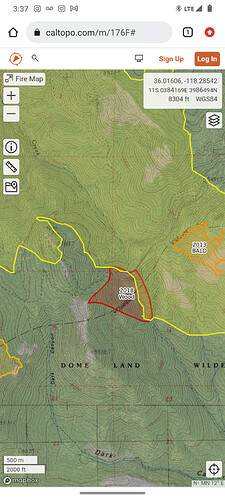Are we providing for too much safety and lost our strong initial attack philosophy now? Does the need for regularly staging initial attack resources hampering that strong initial attack philosophy? How aggressive is that initial attack?
You Damn right it’s hampering it. We use to envelope a lot of these fire. Hose and line going in several different ways on the same fire. Don’t get my wrong I am all for Safety, but sometimes you gotta stay and fight fire. Started in 79 and retired in 2012. Worked both A & B and ran crew. It’s seems firefighting PHILOSPHY has changed.
Gonna chime in here. I think this is true but also not the whole story. A lot has changed in the last five to ten years.
-
The fire environment is more aggressive. I have watched that change with my own eyes as a FOBS and a DIVs. The fuels are more receptive and burn hotter and faster. As one team IC put it last year, “every ten embers are starting 15 spot fires.”
-
I have three new officers at my station. They have less than 10 years COMBINED. Honestly, I want them staging until an experienced BC or Captain arrives to make decisions. I know this is not optimal but it is reality. The crews they command are equally inexperienced. I don’t want to see large acres or homes lost, but I’ll take that everyday over lost lives.
-
It’s not permanent. The fuels situation is not likely to change. But the experience part will. As we all learn how to deal with the new fire environment we will be able to take the initiative back on IA. But right now the risk vs. gain is not there.
When an IC or ECC requires staging on an IA, it generally means there is limited room for resources or maybe an LE issue. In my experience and working with my local resources I have seen aggressive firefighters using sound and safe tactics. This thread started as an IA opinion, large extended attack fires is another subject on the protocols and reasons for staging resources.
So how many times have we heard this statement for a single tree fire “due to firefighter safety they couldn’t put resources on the fire” but punch in the line when it starts to move or they do they like did on the sqf wood fire in 2018 not go in and drop the tree but put in line around about 100 acres and fire it off because of…""“firefighter safety”"". That was seen on the old Sherman peak webcam.
For the record what I was talking about is something entirely different. I was referring to not engaging on fires with active fire behavior until there is a good plan in place. I was not referring to or defending negligence.
I would 100% agree…the days of “anchor and flank” are pretty much gone. It seems a lot of these fire are trying to be stopped with aircraft dropping along ridgelines, hoping they hold but not following up with ground resources. I get there is a lot of new people in the field but you gain experience by getting into the fight.
My comment was just in relation to press releases from an agency over the years and that statement or phrase has seemingly become go to boilerplate relating to some fires over the last few years. Apologies if I came across a little chippy in the other post.
LVDesertrat:
As an ATGS with 20+ years experience nation-wide there is growing trend to wait and see if AC can knock down before many crews engage. I spent 25 years on an Type 3 engine, and many times no AC were there. We’d always try to anchor and flank where possible, laying hose chasing the fire. That was the job we’re hired for!!
Flyron…we must have been taught by those with same mindset.
“Old guys” like you and I were taught by crusty old aggressive FC. We learned to mobile pump from Model 1’s, 5’s, & 9’s with the bumper in the small of out backs. We used smooth bore tips and hiked with Cotton Jack hose in canvas bags.
Our job today is to pass on what was passed to us, while using the modern technology to our advantage. At the same time we have a work force that wants to work “3 & out” or even 4 days and complains about being forced for a 5th straight. They have ZERO concept what the “Nickle” is or even what a 5 day/120hr schedule means.
Just like Sandy Kofax & Nolan Ryan use to pitch on 4-days, regularly pitched complete games throwing 120+ pitches a game. Today, pitchers work a 5 day rotation and get pulled at 80-100 pitches.
We just have to instill our knowledge and work ethics with the today’s FF that are willing to listen and learn.
Because at the end of the day, just as we replaced that crusty, Chain smoking FC. These “kids” will someday replace us.
Preach it Ehoss
There is a fine line between engaging responsibly, not freelancing and adding to command confusion, inadvertently placing yourself in harms way, taking initiative when it is warranted, and rapidly developing a plan to prevent command paralysis.
I was referring to not engaging on fires with active fire behavior until there is a good plan in place. I was not referring to or defending negligence. ( 2ndLine1stWord)
Agree. In my opinion, engaging haphazardly is counterproductive. That being said, who ever arrives first on-scene should develop and lay out the plan and folks should then be directed to properly engage according to that plan–and that should occur rapidly. Simple anchor and flank, establish and resource DIVS A and DIVS Y, and move forward, etc. Refine it as you proceed. You will never have a perfect plan or a 100% plan, so deal with it as issues come up.
If there are mitigating circumstances such as poor or no access, inability to obtain good SA on the incident, then not prematurely committing resources to an ill advised plan may require some staging. However, staging paralysis should never be the plan. In SoCal one of the issues is that if you ask for 50 engines you are not only going to get them, but they will arrive significantly faster than you think and often before you might be ready. As “Bruno” once said, if you don’t have a plan, then don’t add resources to it. It is up to the first in officers and chiefs to have the ability to rapidly develop and communicate the plan to prevent unnecessary staging. If they don’t have the slides in their slide trays then we need to run them through scenarios and exercises to help them develop some slides–and give them opportunities on actual incidents to be mentored. In my book, staging all resources until a chief arrives is an ill advised and weak plan. If you don’t/can’t trust your company officers then train and exercise them using bread and butter scenarios.
On a related note, this short video from LACo discusses their TIER acronym. They are starting to use this to avoid staging paralysis on larger incidents.
TIER - Take Initiative, Engage, and Report
Fire is still being fought aggressively by those of us with experience on the engine. But loosing your whole back seat does bring your trust level down quite a bit. Times are changing and we no longer have the cream of the crop to rely on
Well stated IMT_Geek.

I’m starting to get the feeling we are all saying the same thing just in different ways lol.
I completely agree. I think anyone would. The experience levels have significantly dropped over past decades. It really places the current crop of experienced officers and chiefs in the position of – like it or not – developing those below you. In my last years that’s all I seemed to do, succession exercises to make my retirement easy–so they wouldn’t even notice I was gone (that was my goal).
As an example, one of my first exercises that the folks really enjoyed, was at company officer (CO) meetings I would have all the COs in one room and one CO in a room with me. I might give all of them them a “dispatch” they would get on the radio at dispatch, then I would show the one CO a power-point slide of an area in their first in – only with fire. It might be a structure, it might be a wildland fire, it depended. Then the CO would have to give their on-scene description (OSD) over the radio to the “responding” COs in the other room who couldn’t see the scene. After that I would blank out the slide and the COs would get back together and they would describe to the CO giving their OSD what they thought they were getting into. Then they all got to see what the one CO did. After about 5 or 6 slides, some good ribbing and conversations, and taking turns and talking through what each of them could do to help each other “see” what they were getting into, our department standard SOG descriptions significantly improved and their discussions and enlightenment was awesome. I could then just listen and take notes for cheat sheets that they received. Crawl - walk - run.
If your not BUILDING LINE, (Perimeter Control) YOUR NOT PUTTING OUT FIRE.
Amen to that
You sir have addressed “The Elephant in the Room”. The GREAT BADGE GIVE AWAY seems to only have accelerated since the pandemic. The game of musical chairs to those of us old enough to remember has changed. Gone are the days of 10-1,000 applications for 1-5 jobs. Today it is at best 1:1 across the workers in ALL TRADES. I teach and train my FF that they will be my replacement one day SOON. In some aspects it’s a zero sum game. “You’re either going to be led by the idiot or the idiot doing the leading” I have told them my level of engagement changes based on my crew and the rest of the personal working in the Battalion that day. Look no further than what is happening to the federal agencies and Calfires continued expansion of hand crews and further augmentation of existing staffing.
The bottom line is this. Just as the work load is ever increasing, the available labor pool continues to shrink. At the end of the day, as a Donald Rumsfeld said “You go to war with the Army you have, not the Army you want”
